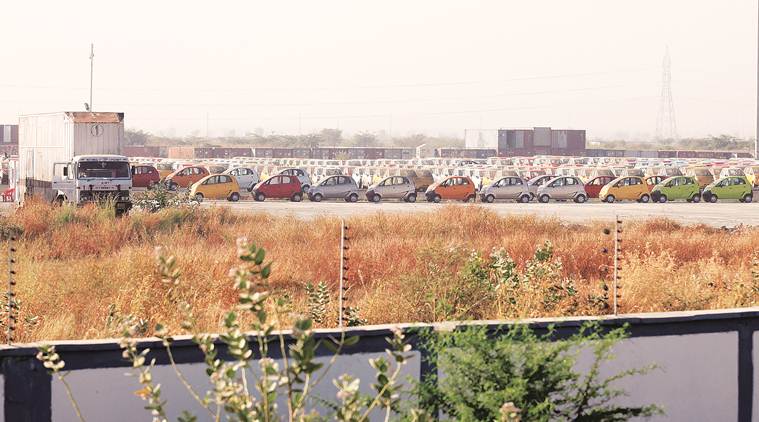 The Tata Motors plant at Sanand, where the Rs 1-lakh car once used to line up, ready to be shipped to different parts of the country. (File Photo)
The Tata Motors plant at Sanand, where the Rs 1-lakh car once used to line up, ready to be shipped to different parts of the country. (File Photo)
It is difficult to spot a Tata Nano in the parking bay at the backyard of the Tata Motors plant at Sanand where once the Rs 1-lakh car used to line up ready to be shipped to different parts of the country. The Nanos of different hues have mostly been replaced by Tiagos and Tigors now.
The plant is currently operating at 100 per cent of its capacity of 2.5 lakh cars. However, in June, only one Nano was manufactured at the factory which has shifted its focus to manufacturing hatchbacks, sedans and the more modern electric vehicles. “This parking lot once used to be full of Tata Nanos. Today other brands have taken over and we transport more than 500-600 cars that roll out of this plant every day,” said an employee of one of the logistic firms stationed at Sanand for providing transportation facilities to the automobile manufacturer.
Compared to the one Nano manufactured in June, 275 units were produced during the same month in 2017. Tata Motors sold just three Nanos in June, compared to 167 units during the same period in 2017. However, the company said it will continue to be produced at Sanand plant till a decision to continue the model beyond 2019 is arrived at.
“The hatchback segment is very important to us and the regulations and customer preferences are going to play a major role in defining various sub-segments within this segment. We already have a well-defined passenger vehicle strategy in place that will look at not only the best way of addressing the segments’ requirements but also an overall perspective of portfolio. We are well aware that the Nano in its present form cannot continue beyond 2019 and may need fresh investments to survive. No decision has been made yet in this regard. Meanwhile, we continue to produce Nano catering to customer demand in key markets,” said a spokesperson of Tata Motors when quizzed about the future of the Tata Nano.
The plant that began with 2,400 employees currently has a workforce of about 4500 who work in two shifts.
The production of Tiago started in 2016, while that of Tigor began in 2017. In the recent past, the plant has also been remodelled to produce the Tigor-EV which is the electric variant of the compact sedan. In January 2018, the company rolled out the first batch of electric vehicles from the Sanand facility in the presence of Tata Group patriarch Ratan Tata. The company has an order to deliver 250 Tigor EVs to state-run Energy Efficiency Services Ltd (EESL) and all of it is being made at Sanand.
The Tata Nano project made Sanand its home in 2008 after shifting its base from Singur in West Bengal due to protests against land acquisition. Set up on 1100 acres with an investment of Rs 2000 crore, the Sanand facility has produced about 12 different variants of Tata Nano in about eight colours.
The facility continues to make engines for Tata Nano and also manufacturers petrol and diesel engines for different variants of Tiago and Tigor. It also manufactures petrol engines of the latest SUV from the Tata stable, Nexon.
The adjoining Tata Motors vendor park currently houses over 25 ancillary units that supply various components of the Tata Motors facility. However, this is a far cry from the 41 vendors to whom plots were alloted when Tata Nano first began operations in June 2010.
The changes in the company’s strategy for the Sanand plant can be traced back to June 2014, when Tata Motors began contemplating on producing other models at this facility near Ahmedabad. The same year, the plant was shut down for 40 days for “routine maintenance”. During this period, pile-up of unsold inventory had forced the Sanand facility to operate at just five per cent of it’s annual capacity.
In an interview to The Indian Express in May 2015, the then Chief Secretary D J Pandian went public about the idle capacity at the plant and asked the company to manufacture something else after submitting a fresh proposal. A flash strike by over 400 workers demanding better wages and formation of an union threatened to disrupt operations at the plant in February 2016. Though the issue was resolved, fortunes of the Nano model failed to look up.